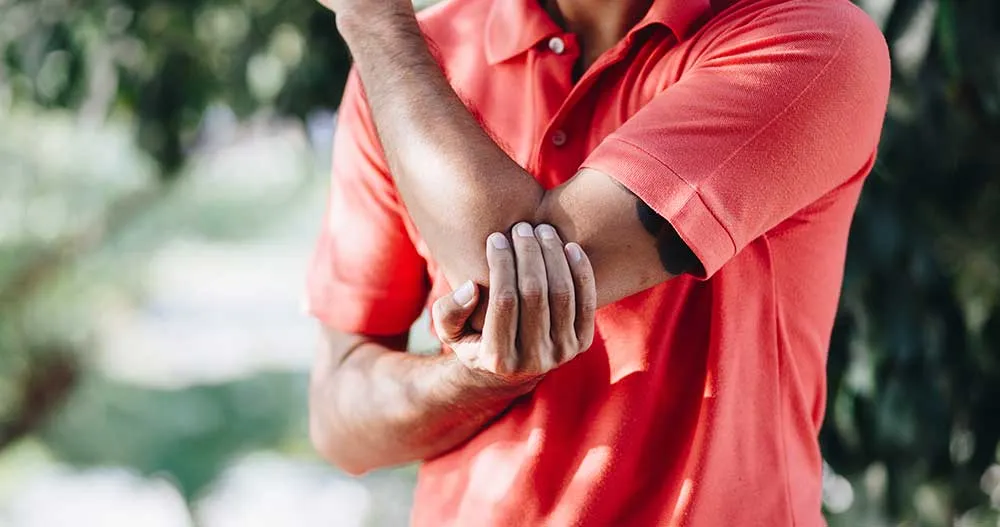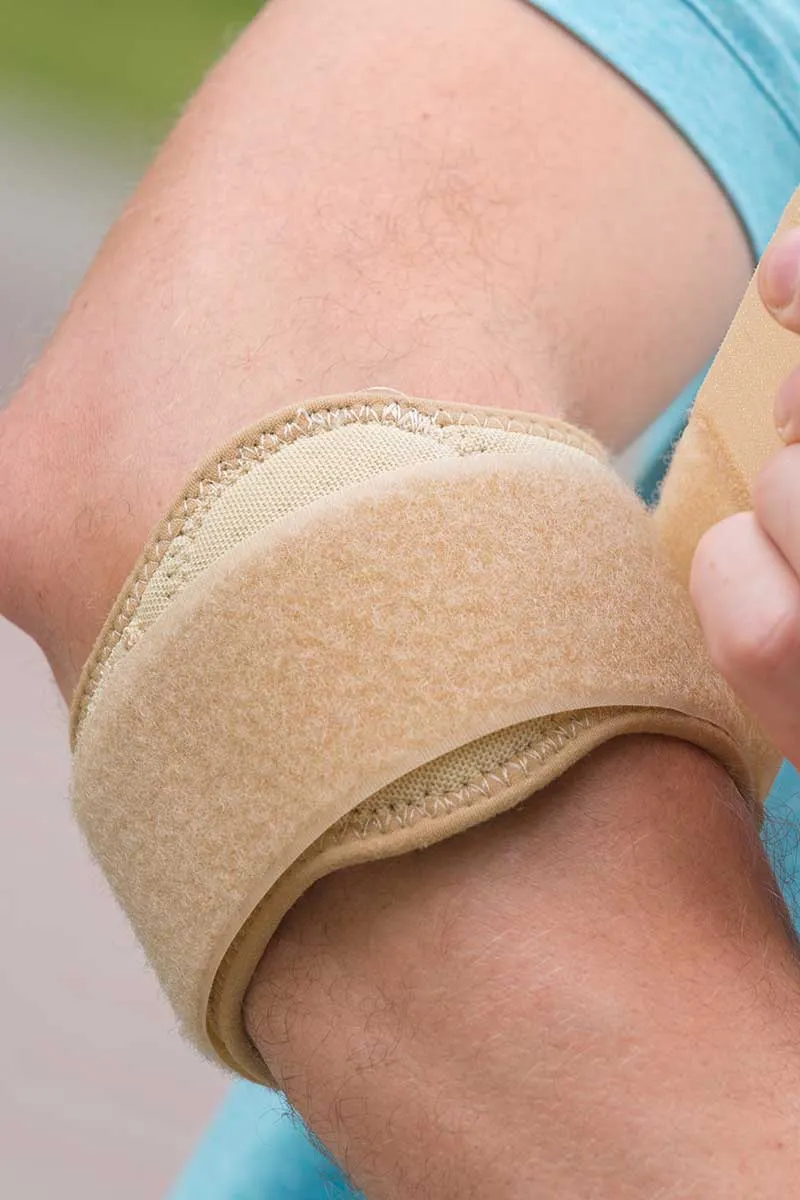
Tennis elbow is a common condition that causes pain in the outer aspect of the elbow joint. It is also known as lateral epicondylitis. Tennis elbow is caused by overuse of the muscles and tendons that lift the wrist and extend (straighten) the fingers, that attach to the outer aspect of the elbow.

Tennis elbow can affect people of all ages, but it is most common in adults between the ages of 30 and 50. It is also more common in people who participate in activities that require repetitive movements of the wrist and forearm, such as tennis, golf, DIY and weightlifting.
Other risk factors for tennis elbow include:

The main symptom of tennis elbow is pain that localises to the outside of the elbow. The pain may be worse with activity, especially activities that involve twisting the wrist or gripping objects. Tennis elbow is often seen following a sudden increase in the volume or intensity of activity, i.e. playing tennis every day on holiday or painting a room. Patients often describe pain with lifting and pouring, for example a heavy kettle or when ironing.
Other symptoms of tennis elbow may include:



The diagnosis of tennis elbow is usually made based on the patient's medical history and physical examination. The doctor will ask about the patient's symptoms and activities. The doctor will also examine the elbow for pain, tenderness, and range of motion limitations. Imaging tests, such as X-rays, ultrasound or MRI scans, may be ordered to clarify the diagnosis. Under ultrasound assessment the clinician will be looking for structural changes in the Common Extensor Origin, the tendon in the forearm that attaches to the outer side of the elbow. They will also assess for abnormally high blood flow into the tendon, a hallmark of tendon overload associated with tennis elbow.


Treatment for tennis elbow typically focuses on relieving pain and strengthening the muscle and tendon to be able to tolerate the loads that the individual requires, i.e. being able to play tennis for 2 hours twice a week. Non-surgical treatments are often effective. Non-surgical treatments may include:

At The Joint Injection Clinic, these injections are performed after a thorough consent process, whereby the risk and benefits of the procedure are discussed in detail with your doctor. The experienced medical doctor will then place you seated in a chair, across the couch with your elbow bent to 90 degrees and resting on the bed. The elbow is cleaned using a cleaning solution to ensure that the procedure is performed under sterile conditions. Local anaesthetic is often then injected from the skin to the tendon under ultrasound guidance. After giving the local anaesthetic a few minutes to take effect, the tendon injection is performed with a small dose of steroid and local anaesthetic.
The injection itself is normally completed within 30-60 seconds, after which a plaster is applied and post-injection advice is given. The patient is advised to look out for any signs of infection, specifically to check whether the local area becomes red, hot, tender, swollen or if they develop a fever. If this occurs then the patient is asked to contact the clinic immediately at which time a formal reassessment will occur and if needed oral antibiotics can be prescribed. The patient is also warned that following any injection they may notice a short-term worsening or flare in their symptoms after the local anaesthetic has worn off (4-5 hours). This may last for 3-5 days and the patient is advised to consider icing of the area using an ice pack for 10-15 minutes every hour as required.
A PRP injection involves taking 10mls blood from the elbow as per a normal blood test. The blood is then centrifuged (spun down) to separate the platelet-rich part from the red blood cells. The platelet-rich part contains growth factors and signalling molecules that can help to increase tendon cell proliferation and reduce tendon inflammation. 3-5 mls of PRP is then injected under ultrasound guidance to the tendon.
If non-surgical treatments are not effective, surgery may be an option. A Tennis elbow release describes the minimally invasive surgery that involves releasing of the tightened tendons that are causing the pain in the outer part of the elbow.
The best treatment option for you will depend on the severity of your tennis elbow, your overall health, and your activity level.
Additional tips for managing tennis elbow pain:
If you are experiencing pain and stiffness in your elbow, it is important to see a doctor to get a diagnosis and discuss treatment options. With early diagnosis and treatment, most people with tennis elbow can recover fully and return to their normal activities.
At The Joint Injection Clinic, we specialise in ultrasound-guided steroid injections for tennis elbow. This is a safe, fast, and effective way to reduce pain and inflammation caused by tendon overload.
We commonly see patients who are unable to wait on NHS waiting lists or who prefer quick access to expert care. We offer appointments in central London at an affordable rate, with no GP referral required.
Treatment Process:
• Performed by an experienced medical doctor
• Local anaesthetic and steroid injected under ultrasound guidance
• Fast procedure: ~60 seconds injection time
• Detailed post-care instructions
Most patients report noticeable pain reduction within 1–2 weeks.
The best treatment depends on the severity and duration of symptoms, but for many people who haven’t responded to rest, ice, or physiotherapy, a steroid injection offers the fastest route to pain relief. At our clinic, we provide ultrasound-guided steroid injections, which target the inflamed tendon directly and reduce irritation around the lateral epicondyle. This allows most patients to return to normal activities far more quickly than with conservative care alone.
No referral is needed. We offer private tennis elbow injections in London without the need to go through NHS channels. If you’re experiencing persistent elbow pain and don’t want to wait on long public healthcare lists, you can book directly with our clinic for a same-week consultation and treatment.
Steroid injections can provide significant short- to medium-term relief for tennis elbow, especially when performed under ultrasound guidance for precise placement. While every case varies, many patients report a noticeable reduction in pain within 7–14 days. Our clinicians will also advise you on how to manage your activity level post-injection to maximise long-term benefit and reduce recurrence.
Recovery time is typically quick. Most patients can resume light activity within 24–48 hours, although we recommend avoiding strenuous wrist or elbow movements for 3–5 days. A mild increase in soreness can occur once the local anaesthetic wears off (usually after 4–6 hours), but this is temporary and can be managed with rest and ice. Your doctor will provide tailored aftercare instructions to support your recovery.
You can receive a private injection at The Joint Injection Clinic, conveniently located in London. Our experienced medical team provides prompt assessments and treatment, often on the same day. We specialise in image-guided musculoskeletal injections, with a focus on safe, precise procedures for patients who prefer not to wait for NHS care.



